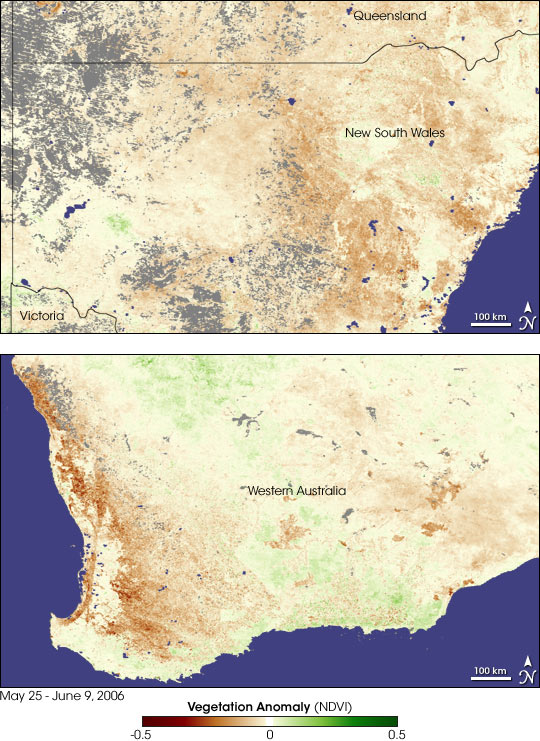


With winter on the near horizon, many Australians again faced the prospect of drought. A dry summer and fall left soil parched and plants stressed. These images show the impact of low rainfall on vegetation in New South Wales and the southwestern tip of Western Australia. Brown regions show where vegetation was stressed or less healthy than the five-year average from 2000 to 2005. Green in sections of Western Australia and southern New South Wales shows where plants were healthier than average. The images were created from data collected by the Moderate Resolution Imaging Spectroradiometer (MODIS) on NASA’s Terra satellite between May 25 and June 9, 2006. Gray areas are places where the satellite didn’t collect data, probably because of persistent clouds.
The images focus on New South Wales and Western Australia, both of which are major crop areas. The dry weather in these crop areas forced many farmers to delay planting winter grains. As a result, says the Australian Bureau of Agriculture and Resource Economics (ABARE), fewer crops were planted, and winter crop production is expected to decline by 11 percent from the 2005-2006 season. In Western Australia, crop areas are concentrated in the southwestern corner, where the impact of drought seems to be the worst. Crops are spread across New South Wales and southern Queensland, where conditions seem to be dry overall.
With winter on the near horizon, many Australians again faced the prospect of drought. A dry summer and fall left soil parched and plants stressed. These images show the impact of low rainfall on vegetation in New South Wales and the southwestern tip of Western Australia. Brown regions show where vegetation was stressed or less healthy than the five-year average from 2000 to 2005. Green in sections of Western Australia and southern New South Wales shows where plants were healthier than average. The images were created from data collected by the Moderate Resolution Imaging Spectroradiometer (MODIS) on NASA’s Terra satellite between May 25 and June 9, 2006. Gray areas are places where the satellite didn’t collect data, probably because of persistent clouds.
The images focus on New South Wales and Western Australia, both of which are major crop areas. The dry weather in these crop areas forced many farmers to delay planting winter grains. As a result, says the Australian Bureau of Agriculture and Resource Economics (ABARE), fewer crops were planted, and winter crop production is expected to decline by 11 percent from the 2005-2006 season. In Western Australia, crop areas are concentrated in the southwestern corner, where the impact of drought seems to be the worst. Crops are spread across New South Wales and southern Queensland, where conditions seem to be dry overall.
NASA image created by Jesse Allen, Earth Observatory, using data provided by Inbal Reshef as part of the Global Agricultural Monitoring Project between NASA, USDA’s Foreign Agricultural Service (FAS), and the University of Maryland.